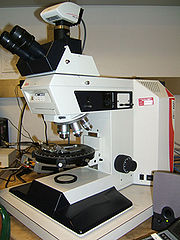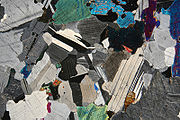
Petrographic microscope
Encyclopedia



Optical microscope
The optical microscope, often referred to as the "light microscope", is a type of microscope which uses visible light and a system of lenses to magnify images of small samples. Optical microscopes are the oldest design of microscope and were possibly designed in their present compound form in the...
used in petrology
Petrology
Petrology is the branch of geology that studies rocks, and the conditions in which rocks form....
and optical mineralogy
Optical mineralogy
Optical mineralogy is the study of minerals and rocks by measuring their optical properties. Most commonly, rock and mineral samples are prepared as thin sections or grain mounts for study in the laboratory with a petrographic microscope...
to identify rocks
Rock (geology)
In geology, rock or stone is a naturally occurring solid aggregate of minerals and/or mineraloids.The Earth's outer solid layer, the lithosphere, is made of rock. In general rocks are of three types, namely, igneous, sedimentary, and metamorphic...
and mineral
Mineral
A mineral is a naturally occurring solid chemical substance formed through biogeochemical processes, having characteristic chemical composition, highly ordered atomic structure, and specific physical properties. By comparison, a rock is an aggregate of minerals and/or mineraloids and does not...
s in thin section
Thin section
In optical mineralogy and petrography, a thin section is a laboratory preparation of a rock, mineral, soil, pottery, bones, or even metal sample for use with a polarizing petrographic microscope, electron microscope and electron microprobe. A thin sliver of rock is cut from the sample with a...
s. The microscope is used in optical mineralogy
Optical mineralogy
Optical mineralogy is the study of minerals and rocks by measuring their optical properties. Most commonly, rock and mineral samples are prepared as thin sections or grain mounts for study in the laboratory with a petrographic microscope...
and petrography
Petrography
Petrography is a branch of petrology that focuses on detailed descriptions of rocks. Someone who studies petrography is called a petrographer. The mineral content and the textural relationships within the rock are described in detail. Petrographic descriptions start with the field notes at the...
, a branch of petrology
Petrology
Petrology is the branch of geology that studies rocks, and the conditions in which rocks form....
which focuses on detailed descriptions of rocks. The method is called "polarized light microscopy" (PLM).
Depending on the grade of observation required, petrological microscopes are derived from conventional brightfield microscopes of similar basic capabilities by:
- adding a polarizerPolarizerA polarizer is an optical filter that passes light of a specific polarization and blocks waves of other polarizations. It can convert a beam of light of undefined or mixed polarization into a beam with well-defined polarization. The common types of polarizers are linear polarizers and circular...
filter to the light path beneath the sample slide - replacing the normal stage with a circular rotating stage (typically graduated with vernier scaleVernier scaleA vernier scale is an additional scale which allows a distance or angle measurement to be read more precisely than directly reading a uniformly-divided straight or circular measurement scale...
s for reading orientations to better than 1 degree of arc) - adding a second rotatable and removable polarizerPolarizerA polarizer is an optical filter that passes light of a specific polarization and blocks waves of other polarizations. It can convert a beam of light of undefined or mixed polarization into a beam with well-defined polarization. The common types of polarizers are linear polarizers and circular...
filter, called the analyzer, to the light path between objective and eyepiece - adding a Phase telescopePhase telescopeA phase telescope or Bertrand lens is an optical device used in aligning the various optical components of a light microscope. In particular it allows observation of the back focal plane of the objective lens and its conjugate focal planes...
, also known as a Betrand Lens, which allows the viewer to see conoscopic interference patternConoscopic interference patternA conoscopic interference pattern or interference figure is a pattern of rings caused by optical interference observed when diverging light rays travel through a non isotropic substance. It is the best way to determine if a mineral is uniaxial or biaxial and also for determining optic sign in...
s - adding a slot for insertion of wave plateWave plateA wave plate or retarder is an optical device that alters the polarization state of a light wave travelling through it.- Operation :A wave plate works by shifting the phase between two perpendicular polarization components of the light wave. A typical wave plate is simply a birefringent crystal...
s
Petrographic microscopes are constructed with optical parts that do not add unwanted polarizing effects due to strained glass, or polarization by reflection in prisms and mirrors. These special parts add to the cost and complexity of the microscope. However, a "simple polarizing" microscope is easily made by adding inexpensive polarizing filters to a standard biological microscope, often with one in a filter holder beneath the condenser, and a second inserted beneath the head or eyepiece. These might be sufficient for many non-quantitative purposes.
The two filters of the petrographic microscope have their polarizing planes oriented perpendicular to one another. When only an isotropic material such as air, water, or glass exists between the filters, all light is blocked. However, most crystalline materials and minerals change the polarizing light directions, which allows some of the altered light to pass through the analyzer to the viewer. Using one polarizer allows for looking at the slide in plane polarized light, while using two allows for analysis under cross polarized light. A particular light pattern on the upper lens surface of the objectives is created as an conoscopic interference pattern
Conoscopic interference pattern
A conoscopic interference pattern or interference figure is a pattern of rings caused by optical interference observed when diverging light rays travel through a non isotropic substance. It is the best way to determine if a mineral is uniaxial or biaxial and also for determining optic sign in...
characteristic of uniaxial and biaxial minerals, and produced with convergent polarized light
Conoscopy
Conoscopy is an optical technique to make observations of a transparent specimen in a cone of converging rays of light...
. To observe the interference figure, true petrographic microscopes usually include an accessory called a Bertrand lens, which focuses and enlarges the figure. It is also possible to remove an eyepiece lens to make a direct observation of the objective lens surface.
In addition to modifications of the microscope's optical system, petrographic microscopes allow for the insertion of specially-cut oriented filters of biaxial minerals (named the Quartz Wedge, quarter-wave mica plate
Wave plate
A wave plate or retarder is an optical device that alters the polarization state of a light wave travelling through it.- Operation :A wave plate works by shifting the phase between two perpendicular polarization components of the light wave. A typical wave plate is simply a birefringent crystal...
and half-wave mica plate
Wave plate
A wave plate or retarder is an optical device that alters the polarization state of a light wave travelling through it.- Operation :A wave plate works by shifting the phase between two perpendicular polarization components of the light wave. A typical wave plate is simply a birefringent crystal...
), into the optical train between the polarizers to identify positive and negative birefringence
Birefringence
Birefringence, or double refraction, is the decomposition of a ray of light into two rays when it passes through certain anisotropic materials, such as crystals of calcite or boron nitride. The effect was first described by the Danish scientist Rasmus Bartholin in 1669, who saw it in calcite...
, and in extreme cases, the mineral order when needed.
External links
- Nikon: Introduction to Polarized Light Microscopy
- Olympus: Polarized Light Microscopy
- Geological Microscopes
- A virtual Polarizing Microscope
- PETROG Stepping Stage: An ideal upgrade from the Prior / Hacker Swift electro-mechanical stage, a popular device used to point count, that is no longer manufactured.

